Main menu
Common skin conditions

NEWS
Join DermNet PRO
Read more
Quick links
Angioedema — extra information
Angioedema
Author(s): Vanessa Ngan, Staff Writer, 2006 Updated: Dr Georgia Morley, NHS, England. Copy edited by Gus Mitchell. April 2022
Introduction
Demographics
Causes
Clinical features
Variation in skin types
Complications
Diagnosis
Differential diagnoses
Treatment
Outcome
What is angioedema?
Angioedema is a skin reaction similar to urticaria. It is characterised by an abrupt, temporary, localised swelling of the deep dermal layer, subcutaneous tissue, and mucous membranes. Although it can affect any part of the body, it most often occurs around the eyes, lips, and genitals. In severe cases, the internal lining of the upper respiratory tract and intestines may also be affected.
There are multiple types of angioedema, including allergic, drug-induced, idiopathic, and hereditary angioedema (HAE).
Urticaria is the development of transient localised oedema in the dermis, characterised by wheals and often co-exists with angioedema. Wheals are usually superficial skin-coloured or pale swellings, surrounded by erythema.
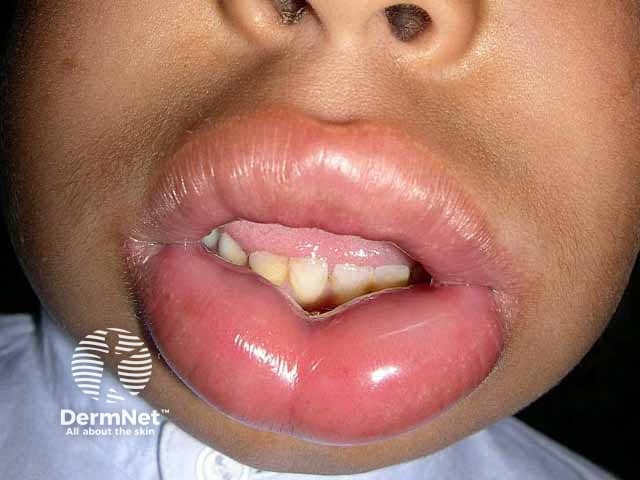
Severe lip angioedema
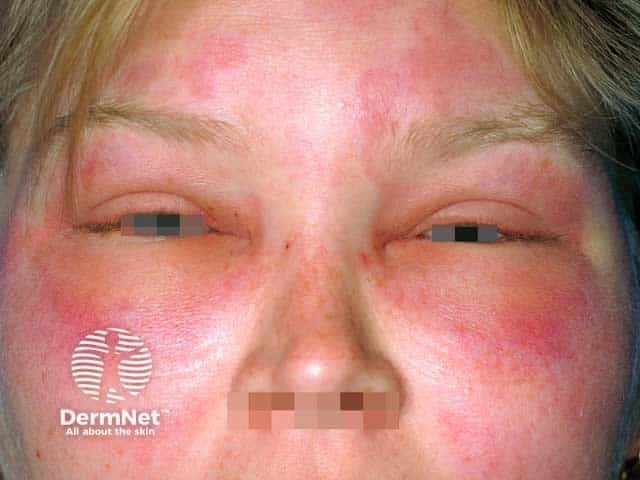
Lid angioedema - there was typical urticaria elsewhere on the body
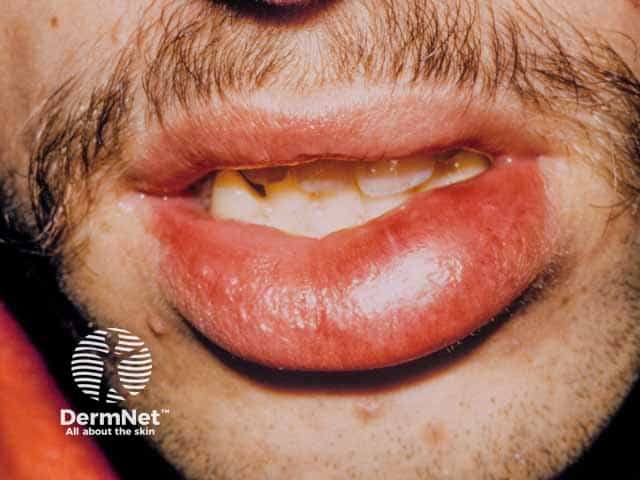
Resolving lip angioedema
Who gets angioedema?
Urticaria is a common skin presentation, affecting up to 20% of people; an estimated 40% of patients with chronic urticaria (lasting over 6 weeks) have associated angioedema. The prevalence of hereditary angioedema is estimated to be 1 in 500,000.
ACE-inhibitor induced angioedema is rare, however, it is the sub-type most likely to result in hospitalisation and is more common in African-Americans.
What causes angioedema?
Angioedema is caused by an increase in local capillary permeability and plasma extravasation, usually mediated by mast cells, histamine, or bradykinin release.
Angioedema is most commonly histamine-mediated; mast cell and basophil stimulation results in histamine release. Angioedema with urticaria tends to suggest a histaminergic form, which includes acute allergic angioedema and histaminergic idiopathic angioedema. The exact cause depends on the type of angioedema a patient has.
Angioedema type |
Causes |
|---|---|
Acute allergic angioedema (almost always occurs with urticaria within 1-2 hours of exposure to the allergen) |
|
Non-allergic drug reaction (onset may be days to months after first taking the medication) |
|
Idiopathic angioedema (frequently chronic and relapsing and usually occurs with urticaria) |
|
Hereditary angioedema (very rare autosomal dominant inherited disease) |
|
Acquired C1 inhibitor deficiency |
|
Inducible angioedema |
|
What are the clinical features of angioedema?
General features include:
- Localised oedema
- Usually affecting eyelids or lips
- Skin-coloured or slightly red in colour
- Associated with burning sensation
- Not itchy
- Non-pitting
- Swelling usually resolve within 24-48 hrs
- Lesions do not weep or blister and resolve without scaling (in contrast to acute eczema)
- May affect other organs such as:
- Intestines — causing abdominal pain
- Upper airway — producing difficulty in breathing and swallowing.
Angioedema type |
Clinical features |
|---|---|
Acute allergic angioedema |
|
Non-allergic drug reaction |
|
Idiopathic/chronic angioedema |
|
Hereditary angioedema |
|
Angioedema features
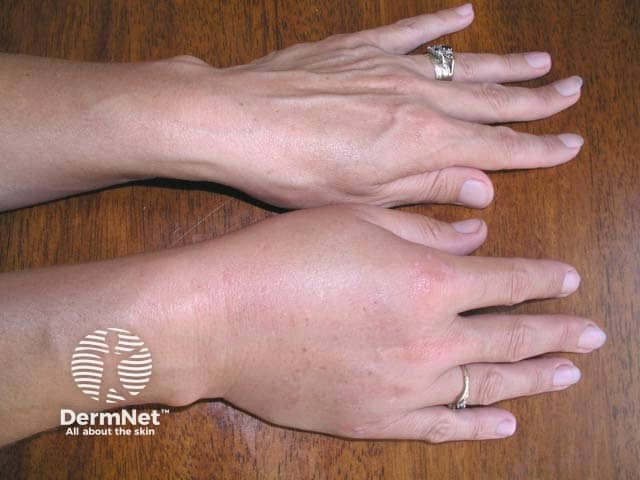
Angioedema of the right hand
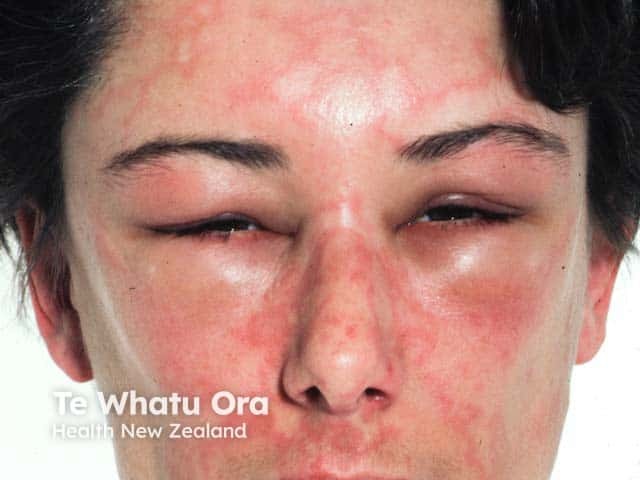
Angioedema and facial urticaria
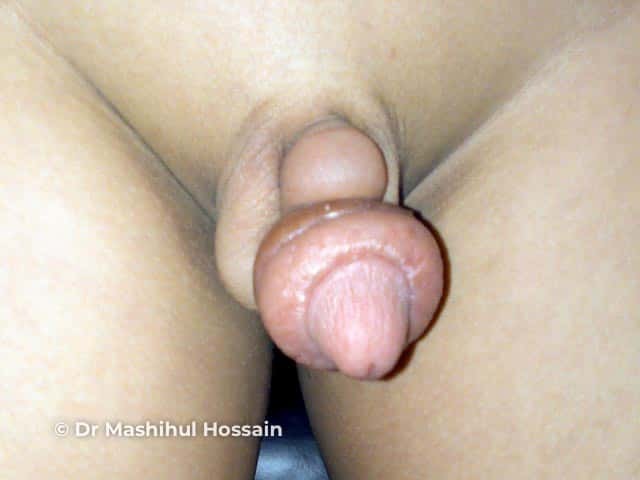
Angioedema of the penis and prepuce
How do clinical features vary in differing types of skin?
When angioedema is associated with urticaria, erythematous skin may appear purplish on darker skin tones.
What are the complications of angioedema?
- Tongue or throat swelling — difficulty breathing.
- Can be life-threatening if the airway is involved.
How is angioedema diagnosed?
Angioedema is usually diagnosed following clinical examination and detailed history taking. Important features include:
- Time of onset
- Exposure to potential allergens
- Drug history eg, ACE inhibitors
- Family history of allergies, skin rashes, or angioedema.
Examination of the patient is important for assessing severity and determining the likely cause.
- Airway should be assessed and secured first
- Signs of upper airway involvement
- Including stridor, difficulty in breathing talking and swallowing
- Urticaria present or not
- Areas involved
- Face, lips, genitals, tongue
- Abdominal pain and swelling
- Can be a sign of HAE, important to rule out other causes
- Signs of anaphylaxis
- ie, rule out anaphylaxis as a life-threatening differential – sudden onset of symptoms, airway, breathing or circulation problems, signs of shock.
If hereditary angioedema is suspected, testing can find low C4 and C1-INH levels (part of the complement system). However, cases of HAE with normal C4 levels have been reported.
Skin prick testing or RAST testing may be used when allergic angioedema is suspected.
What is the differential diagnosis for angioedema?
- Anaphylaxis
- Hereditary angioedema
- Cellulitis
- Allergic contact dermatitis
- Drug hypersensitivity syndrome
What is the treatment for angioedema?
Treatment is dependent on the subtype of angioedema. Angioedema is usually treated in the same way as acute urticaria when mild.
General measures
- Aim to identify potential triggers.
- Avoidance or removal of causative agents eg, allergens, drugs.
- Adequate observation time in a hospital environment if angioedema has continued to progress despite treatments.
Specific measures
Allergic and Idiopathic Histaminergic Angioedema
- For very mild symptoms, treatment may not be required
-
Antihistamines in the acute phase
- Non-sedating second-generation antihistamines tend to be used first-line e.g. cetirizine, loratadine
- Higher than usual (four times the standard) doses may be necessary
- Prophylactic antihistamines may be used
- Depending on the severity or with impending airway jeopardy, a short course of oral steroids eg, prednisolone as well as adrenaline may be required.
- Tranexamic acid can be offered for refractory recurrent angioedema
- Omalizumab may be reserved as prophylaxis for refractory recurrent angioedema
- Adrenaline autoinjectors are seldom required for angioedema with weals
Hereditary and Acquired Angioedema due to C1INH deficiency
Treatment for HAE aims to decrease morbidity and mortality, and reduce the need for hospitalisation.
Acute presentations
- C1-INH replacement - human plasma-derived treatments administered via Intravenous injection eg, complement C1 esterase inhibitors (Berinert, Cinryze)
- Bradykinin antagonists eg, Icatibant
Prophylaxis
- Androgen therapy eg, Danazol
- Side effects should be considered including weight gain, menstrual irregularities, and hirsutism
- Tranexamic acid
For more information, see Hereditary angioedema.
What is the outcome for angioedema?
The prognosis of angioedema is dependent on the presentation, severity and the initiation of, and response to appropriate treatment.
Mild symptoms often self-resolve within 72 hours. However, angioedema can be life-threatening, particularly after insect bites and stings, and in hereditary and ACE-inhibitor induced angioedema if there is airway involvement. This requires emergency assessment and intervention.
Bibliography
- Cicardi M, Aberer W, Banerji A. Classification, diagnosis and approach to treatment for angioedema: consensus report for the Hereditary Angioedema International Working Group. Eur J Allergy Clin Immunol. 2014; 69:602–16. DOI: 10.1111/all.12380. Journal
- Depetri F, Tedeschi A, Cugno M. Angioedema and emergency medicine: from pathophysiology to diagnosis and treatment. Eur J Intern Med. 2019; 59: 8–13. DOI: 10.1016/j.ejim.2018.09.004. Journal
- Kaplan AP. Angioedema. World Allergy Organ J. 2008;1(6):103–13. doi:10.1097/WOX.0b013e31817aecbe. PubMed
- Misra L, Khurmi N, Trentman T. Angioedema: Classification, management and emerging therapies for the perioperative physician. Indian J Anaesth. 2016;60(8): 534–41. doi: 10.4103/0019-5049.187776. Journal
- Powell R, Leech S, Till S, Huber P, Nasser S, Clark A. BSACI guideline for the management of chronic urticaria and angioedema. Clin Exp Allergy. 2015; 45: 547–65. Guideline
- Radonjic-Hoesli S, Hofmeier K, Micaleto S, Schmid-Grendelmeier P, Bircher A, Simon D. Urticaria and Angioedema: an Update on Classification and Pathogenesis. Clin Rev Allergy Immunol. 2018; 54(1): 88–101. DOI: 10.1007/s12016-017-8628-1. Journal
On DermNet
- Urticaria
- Acute urticaria
- Chronic urticaria
- Cold urticaria
- Hereditary angioedema
- Vibratory angioedema
- ACE inhibitor-induced angioedema
- Dermatological emergencies urticaria and angioedema
- Anaphylaxis
- Allergies explained
Other websites
- Dermatological emergencies — DermNet e-lecture [Youtube]
- Urticaria and angioedema — British Association of Dermatologists
- Hereditary Angioedema
- HAE UK Patient support
